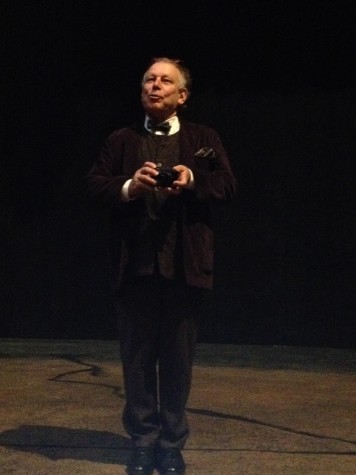Famed designer speaks to students about set design, theater space and life
When Jean Guy Lecat was young, he worked in a factory as a technical drawer and did some amateur theater at night. Lecat wanted to work in theater and went to a big festival in Paris where they had him do little jobs.
One day, he was in the middle of a huge theater with about 3,000 seats and he was responsible for gluing the numbers on the seats.

Behind the stage was a beautiful terrace and in front of the stage, a set design with a wall of painted plants of a deep, dark green.
He kept gluing numbers, one by one, in the hot sun.
At one moment, he heard a cello play on stage. He listened as he continued working. Soon, a violin joined the cello. Together, the sound filled the theater. Then a women started to sing.
“I stopped working,” Lecat said. “It was beautiful. I see the color of the instruments, the green, the sun, this beautiful terrace behind and all these seats. I was the only spectator in the middle of this universe and I said I want to work in theater. It’s so extraordinary.”
So he did, and he’s “done it all,” according to Theatre and Dance Department Chair, Ken Jones who introduced Lecat to the crowd of students that sat mesmerized in NKU’s Corbett Theatre on Monday.
Jones also reminded the students that since Lecat served as technical director and space designer for famed director, Peter Brook, the two are literally in the history books.
“And very rarely will you meet somebody in your theatre history book,” Jones said.
Charlie Roetting, part-time theater instructor, reflected on that fact and said, “It was amazing hearing a living legend talk about his experiences in theatre.”
“I don’t think people understand the gravity of having someone like this present.” Roetting said. “I think it’s huge for [NKU]…it’s good exposure and I think it’s representative of what we are creating.”
Jones added that Lecat had reminded him what theatre is really about and that his passion for theater had been “re-sparked.”
“Hearing about the way [theater] started to where we are now…takes it into the realm of something…sacred,” Jones said.
Still, Lecat said it best when he said that he and the audience would, “explore this theater together,” because the topics he spoke about and the questions he answered covered the gamut.
“What do we need for theater?” Lecat asked.
“We need space,” said someone from the crowd.
“We do not need space first,” Lecat said. “That’s why I ask the question because we jump immediately into form. First, we need the idea to do theater…one person who has this idea.”
Lecat asked what was needed next and the answer was text.
“Theatre without text is not theater,” Lecat said.
After that, comes the actor and the audience.
“No actor, no theater. No audience, no theater. They have to be together,” Lecat said. “That’s important because it’s one of the very few arts that needs both sides.”
Lecat then said what’s needed next is costume, light and then the space.
“It’s important to see all the priority because space comes at the end,” Lecat said. “We know where and when with the costume. We have the atmosphere with the light. All the other information comes from the text so we don’t necessarily need the set. We need the space and the set can be a part of the space.”
Still, Lecat said the set design is important because the way the actor is perceived by the audience often depends on the relationship between the actor and the architecture.
“One of the things [designers] have to do is push by construction, by the color, by the light, push the energy of the actors in the direction of the audience,” Lecat said. “The energy of the space…this is life.”
Andrew Bishop, junior acting major, said this point about the relationship between the actor and the audience really stayed with him.
“The goal is to share, it’s not to show, so you want to be connected to the audience,” Bishop said. “You should be trying to share something. It’s important to share that experience.”
Another important piece of advice Lecat shared is that theater is today and not in the past and how it’s “important to start with nothing.”
“Theater is the opposite of a museum,” Lecat said. “The process of building a play is to have nothing in the beginning. That’s what Peter Brook said in “The Empty Space.” He said, ‘If the space is full of things, especially full of ideas, we cannot start.’ We start together with nothing.”
In modern theater, Lecat said since the time frames of production are often so short, there isn’t time to work with the actors in the space to see what works and what doesn’t because the sets have already been built which can make things complicated.
“Theater has become too sophisticated,” Lecat said. “We have to have a room empty and imagine.”
Jacob Periddy, senior music and theatre double major, said the idea to keep things simple was inspiring and that, “theater is so much more than just people on stage performing for an audience.”
“[Theater’s] this living thing that’s always changing and can be in different forms throughout all of time,” Periddy said.


